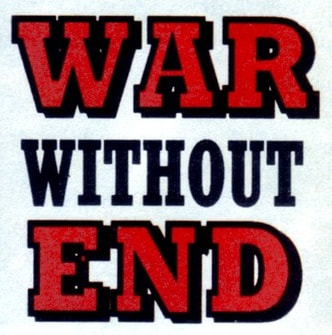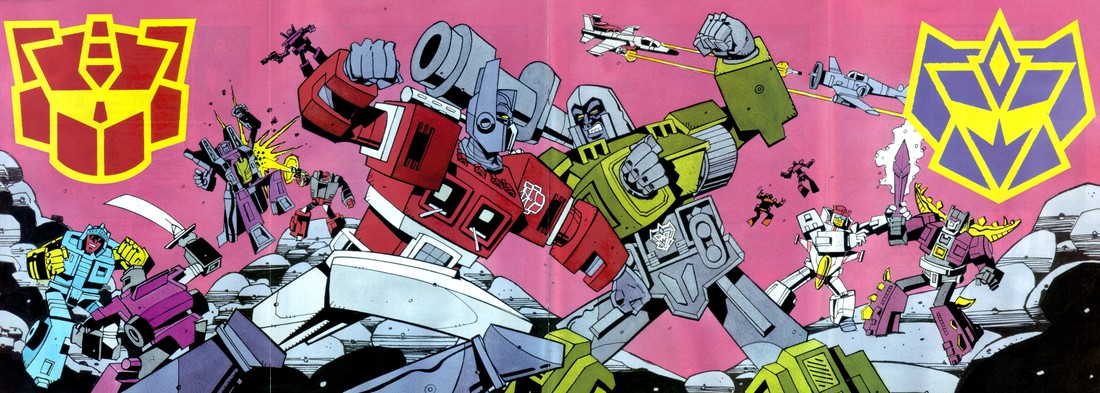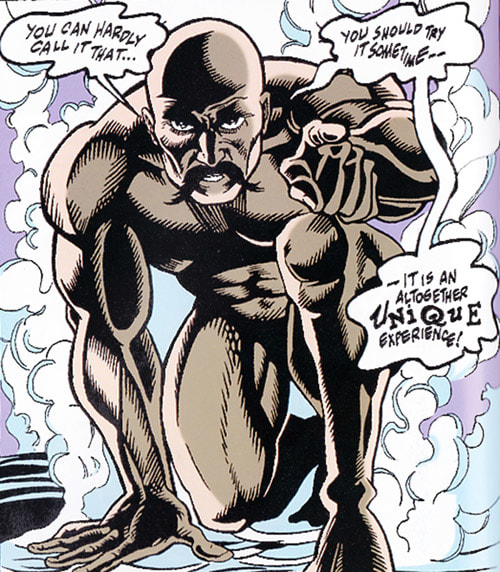Generation Next.
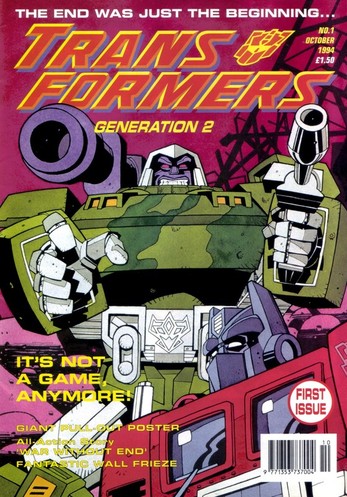
Issue 1: War Without End. September 1994*
*An exact release date doesn’t seem to be online, but going by the 1st October release of issue 2, the 3rd September seems most likely.
Bravo, Prime, bravo!
“The end was just the beginning...” screams the cover, a more defiant tag-line than the American Generation 2 comic’s “Not your father’s Autobot”, and a more hubristic one considering this bold new comic will only last five issues. Though because the UK was still generally a year behind America when it came to toy waves, the US comic actually finished its 12 issue run a month before we saw this issue. The fact they were latching onto a failed title (and as I’ll discuss in a few weeks, you can tell the point early on in that series Furman knew it almost certainly would not carry on past the guaranteed 12 issue) may well explain some of the choices we’re about to see.
Before we dive into the comic though, there’s a lot to talk about. Including the fact that I never owned an issue of this comic at the time. I was certainly aware there was an effort to relaunch Transformers, my younger cousins had several toys (sadly I’d fallen off the wagon during the wilderness years when it was just a European line) and I certainly knew of this comic, seeing it on shelves.
Or rather a shelf. For some reason the only newsagent in my town I saw take it was the one that also sold prestigious amounts of hardcore pornographic magazines. It seems the owner decided that fans of gaping orifices filled with all sorts of things and people who enjoyed Transformers were one and the same. Perhaps he’d owned a Scattershot. Still, that does suggest the distribution wasn’t great for this title, which may have added to its short life.
*An exact release date doesn’t seem to be online, but going by the 1st October release of issue 2, the 3rd September seems most likely.
Bravo, Prime, bravo!
“The end was just the beginning...” screams the cover, a more defiant tag-line than the American Generation 2 comic’s “Not your father’s Autobot”, and a more hubristic one considering this bold new comic will only last five issues. Though because the UK was still generally a year behind America when it came to toy waves, the US comic actually finished its 12 issue run a month before we saw this issue. The fact they were latching onto a failed title (and as I’ll discuss in a few weeks, you can tell the point early on in that series Furman knew it almost certainly would not carry on past the guaranteed 12 issue) may well explain some of the choices we’re about to see.
Before we dive into the comic though, there’s a lot to talk about. Including the fact that I never owned an issue of this comic at the time. I was certainly aware there was an effort to relaunch Transformers, my younger cousins had several toys (sadly I’d fallen off the wagon during the wilderness years when it was just a European line) and I certainly knew of this comic, seeing it on shelves.
Or rather a shelf. For some reason the only newsagent in my town I saw take it was the one that also sold prestigious amounts of hardcore pornographic magazines. It seems the owner decided that fans of gaping orifices filled with all sorts of things and people who enjoyed Transformers were one and the same. Perhaps he’d owned a Scattershot. Still, that does suggest the distribution wasn’t great for this title, which may have added to its short life.
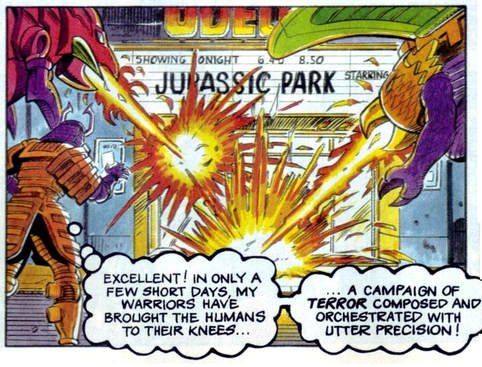 Should have been Star Trek: Generations.
Should have been Star Trek: Generations.
But every month I would happen to be in this newsagents (they sold nice sweets) and would flick through this comic with the same sort of breathless excitement their other customers would be showing. And every month I would try to convince my mother to buy it for me, to which her response would be not at that price.
All of which means there is a mystique to this book for me. It’s the one I touched and came so close to owning, but never actually managed to get. Even knowing the end result isn’t really worthy of such awe doesn’t change that.
Two more related to the contents thoughts. First that there is still some lingering debate over whether Furman actually wrote this, even though its been some years since he claimed otherwise (at an early time in his convention career where he simply may have forgotten about it). Whilst it’s possible his credit is just down to it being heavily adapted from his work and some un-acknowledged soul did the actual writing, unless they come forward, I’m going to take it at face value.
Plus, unlike the theoretical Marvel issue 333, I think it’s more likely Furman would take a step back in his career to a UK licensed comic at a point where a lot of a his American writing gigs had just been cancelled (there was a general cull in 1994, he wryly acknowledges it was the second he got caught up in) and the cash would now be more tempting for a freelancer.
There is also the question of what this book was actually intended to be. Fleetway were the grand old men of British comic publishing. Indeed, they’re exactly the sort of people who would have been a more natural fit for Transformers in 1984, and at this point in time a decade later they still published both The Beano and 2000AD, effectively the full spectrum of British comics. Though for a licensed book, the key reference point would be Sonic the Comic, then a year old and effectively the true successor to Transformers in terms of audience, and with a similar cult following now.
All of which means there is a mystique to this book for me. It’s the one I touched and came so close to owning, but never actually managed to get. Even knowing the end result isn’t really worthy of such awe doesn’t change that.
Two more related to the contents thoughts. First that there is still some lingering debate over whether Furman actually wrote this, even though its been some years since he claimed otherwise (at an early time in his convention career where he simply may have forgotten about it). Whilst it’s possible his credit is just down to it being heavily adapted from his work and some un-acknowledged soul did the actual writing, unless they come forward, I’m going to take it at face value.
Plus, unlike the theoretical Marvel issue 333, I think it’s more likely Furman would take a step back in his career to a UK licensed comic at a point where a lot of a his American writing gigs had just been cancelled (there was a general cull in 1994, he wryly acknowledges it was the second he got caught up in) and the cash would now be more tempting for a freelancer.
There is also the question of what this book was actually intended to be. Fleetway were the grand old men of British comic publishing. Indeed, they’re exactly the sort of people who would have been a more natural fit for Transformers in 1984, and at this point in time a decade later they still published both The Beano and 2000AD, effectively the full spectrum of British comics. Though for a licensed book, the key reference point would be Sonic the Comic, then a year old and effectively the true successor to Transformers in terms of audience, and with a similar cult following now.
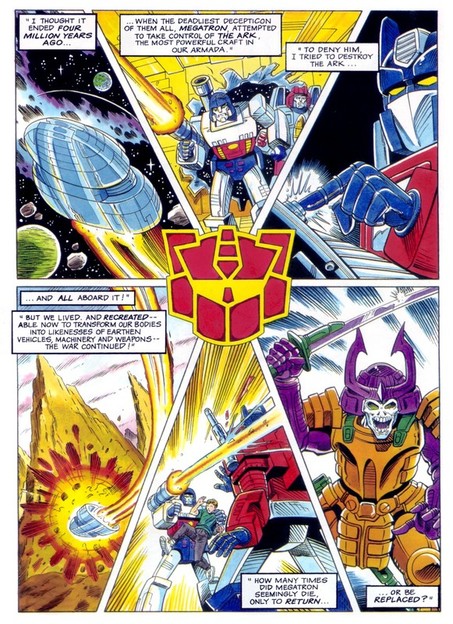 Spot the odd bot out.
Spot the odd bot out.
It’s therefore likely the appeal to Fleetway was a franchise with a proven track record with that demographic and which could be once again turned into a similar (albeit four weekly rather than fortnightly, a format at this point better suited to an anthology) success. Though as Sonic was generally lighter—though still with an edge at times, Lew Stringer was one of the main writers and we’ve seen how he can do comedy with a surprising amount of drama to it—and with more traditional art than the Generation 2 comic had, this meant there would have to be some changes to fit.
Which leads us to my big contentious point. The general assumption amongst fandom has always been that this comic opens with two issues of original material to allow it to skip any connection to the G.I. Joe crossover (long forgotten in the UK by now, and whilst reprinting an issue of Transformers featuring the Joes would likely have been covered by Fleetway’s licence as it has been for their successors, an issue of that series itself would require extra payments not worth the hassle) and give the toys more of a push. Then it was always going to segue into reprints of the American series.
Now, that’s certainly possible, and I’m pretty sure Hasbro UK would have been desperate for a comic with their actual stock front and centre on it. However, I think the original, though very quickly abandoned, plan was for this to be an all original series, for a few reasons, including Fleetway wanting a comic that might not actually get cancelled as quickly as the American.
The big suggestion though is that, as a straightforward replacement for the crossover, the choice of story for this new material makes no sense. Anything you need to know from the Joe issues will be covered easily in about two lines in part 2. The bulk of the story is a straightforward adaptation of some later American G2 material that has nothing to do with the stuff they don’t want to reprint (there’s the briefest appearance from Hawk when Prime arrives on Earth and that’s about it), and should instead prevent them from reusing that material when it came up.
It won’t mind, but it seems issues 4 and 5 at least were done after the axe fell and people stopped caring.
Instead it reads like Furman was expecting to do what he would later do with a lot of the British Armada comic I’ll be covering next month, taking his American stories and compressing and simplifying them for the younger target audience and shorter page count, with the intent being it would be all home-grown content more in the Fleetway style.
Now, the issue with this theory would be that it means that plan was abandoned almost immediately, but if the distribution was as bad generally as in my home town, the first issue could well have done so badly as to require an immediate rethink that kicked in for the third. It might well even be that, after the US series ended, Fleetway decided they were backing a dead duck and let it die on the vine.
Which leads us to my big contentious point. The general assumption amongst fandom has always been that this comic opens with two issues of original material to allow it to skip any connection to the G.I. Joe crossover (long forgotten in the UK by now, and whilst reprinting an issue of Transformers featuring the Joes would likely have been covered by Fleetway’s licence as it has been for their successors, an issue of that series itself would require extra payments not worth the hassle) and give the toys more of a push. Then it was always going to segue into reprints of the American series.
Now, that’s certainly possible, and I’m pretty sure Hasbro UK would have been desperate for a comic with their actual stock front and centre on it. However, I think the original, though very quickly abandoned, plan was for this to be an all original series, for a few reasons, including Fleetway wanting a comic that might not actually get cancelled as quickly as the American.
The big suggestion though is that, as a straightforward replacement for the crossover, the choice of story for this new material makes no sense. Anything you need to know from the Joe issues will be covered easily in about two lines in part 2. The bulk of the story is a straightforward adaptation of some later American G2 material that has nothing to do with the stuff they don’t want to reprint (there’s the briefest appearance from Hawk when Prime arrives on Earth and that’s about it), and should instead prevent them from reusing that material when it came up.
It won’t mind, but it seems issues 4 and 5 at least were done after the axe fell and people stopped caring.
Instead it reads like Furman was expecting to do what he would later do with a lot of the British Armada comic I’ll be covering next month, taking his American stories and compressing and simplifying them for the younger target audience and shorter page count, with the intent being it would be all home-grown content more in the Fleetway style.
Now, the issue with this theory would be that it means that plan was abandoned almost immediately, but if the distribution was as bad generally as in my home town, the first issue could well have done so badly as to require an immediate rethink that kicked in for the third. It might well even be that, after the US series ended, Fleetway decided they were backing a dead duck and let it die on the vine.
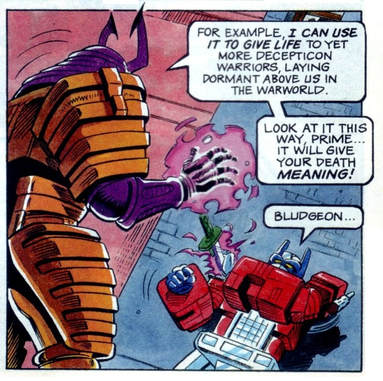 Do you want to join the red hand gang?
Do you want to join the red hand gang?
All speculation of course, but it brings us to the actual comic, War Without End, the same name as the first American issue.
Now, I described this title as not being very good, but I was more thinking of the later issue with much less effort put into them. Fans do tend to be dismissive of the UK material in relation to the US, and even previous UK stories, but there’s actually a lot of charm here.
The first thing to note is, compared to the very 1994 packaging it comes in, this comic looks very old fashioned. Marvel UK old hand Ron Smith’s art could easily fit into one of the early Annuals, and that creates a disconnect from the writing. Furman may be streamlining his story, but there’s very little in the dialogue and plot to suggest he’s aiming younger. It’s still full of apocalyptic visions, grimdark lines (especially from Optimus) and moments that, in the hands of other artists, could be extremely violent. The art alone completely changes the tone of the material, and if nothing else shows what a collaboration comics are.
Perhaps surprisingly from a modern perspective, the issue opens with a direct connect to the Marvel series, as we start with a very rapid recap of the story so far as the war on Cybertron is quickly summed up, along with it ending on a world “Billions of light years distant”, which is implied to be Earth, shown with Bludgeon’s War World (faithful to its look in the US comic) in orbit.
Bludgeon’s presence is perhaps the biggest sign that there was originally no intent to reprint American material. Every other character in this issue outside of a brief two panel appearance of the original Megatron in a flashback is a Generation 2 toy (all under the UK names). Even an slightly off-colour Generation 2 Ramjet is alongside said Megatron as he boards the Ark. The edict is clear, only current product is to be featured. If Bludgeon was going to be in the reprints anyway, he could easily have been replaced by an actual G2 toy acting as a leader of a separatist faction in a similar plot and would have worked just as well. Plus it would have avoided any potential contradictions with the reprint material.
Instead it feels Furman just likes Bludgeon so much he’s decided to throw him in anyway for the fun of it as he reworks his US writing.
Now, I described this title as not being very good, but I was more thinking of the later issue with much less effort put into them. Fans do tend to be dismissive of the UK material in relation to the US, and even previous UK stories, but there’s actually a lot of charm here.
The first thing to note is, compared to the very 1994 packaging it comes in, this comic looks very old fashioned. Marvel UK old hand Ron Smith’s art could easily fit into one of the early Annuals, and that creates a disconnect from the writing. Furman may be streamlining his story, but there’s very little in the dialogue and plot to suggest he’s aiming younger. It’s still full of apocalyptic visions, grimdark lines (especially from Optimus) and moments that, in the hands of other artists, could be extremely violent. The art alone completely changes the tone of the material, and if nothing else shows what a collaboration comics are.
Perhaps surprisingly from a modern perspective, the issue opens with a direct connect to the Marvel series, as we start with a very rapid recap of the story so far as the war on Cybertron is quickly summed up, along with it ending on a world “Billions of light years distant”, which is implied to be Earth, shown with Bludgeon’s War World (faithful to its look in the US comic) in orbit.
Bludgeon’s presence is perhaps the biggest sign that there was originally no intent to reprint American material. Every other character in this issue outside of a brief two panel appearance of the original Megatron in a flashback is a Generation 2 toy (all under the UK names). Even an slightly off-colour Generation 2 Ramjet is alongside said Megatron as he boards the Ark. The edict is clear, only current product is to be featured. If Bludgeon was going to be in the reprints anyway, he could easily have been replaced by an actual G2 toy acting as a leader of a separatist faction in a similar plot and would have worked just as well. Plus it would have avoided any potential contradictions with the reprint material.
Instead it feels Furman just likes Bludgeon so much he’s decided to throw him in anyway for the fun of it as he reworks his US writing.
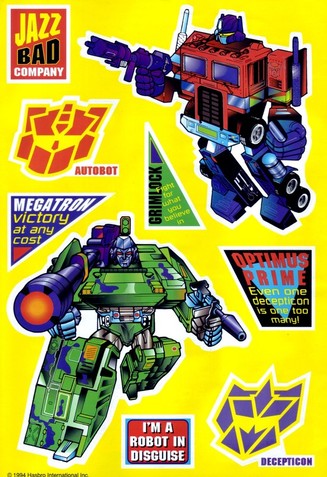 A sticky situation.
A sticky situation.
(I’ll say here, all my speculation assumes that at least at this early stage, someone working on the book gave a fuck. This may well not have been the case.)
The following two page spread gives us something that, surprisingly, the Marvel comic’s brief visits to the UK have avoided, full on location destruction porn as Bludgeon’s troops wreck havoc outside the Houses of Parliament. Though equally surprisingly it is basically limited to just this spread, but it’s a well done money shot that makes for a great introduction to the series. Though showing the Firecons attack a cinema showing the year old Jurassic Park feels like a boast too far.
Bludgeon (and his being faithfully and repeatedly drawn in his character model feels odd after Wildman’s more angular and pointy design) has a very simple plan: Blow shit up and kill people until Optimus Prime turns up.
Amusingly though, as we cut away to the newly arrived Prime by an Autobot shuttle, it turns out he’s come to the planet because Grimlock has phoned him up for a meeting. The sight of the wrecked London does bring out the full Furman though, as he bemoans the thousands of human deaths caused by him having assumed the Decepticon menace was over (a similar theme was explored in Another Time and Place but really isn’t so hammered home in the US comic, again suggesting this is indeed original Furman rather than someone else adapting him).
Which is a sign of how much darker Furman is going with his writing at this point, previously we’ve had discussions of the risk to human life, but it’s never been stated so starkly before that the Decepticons are killing people left right and centre as they pillage.
The following two page spread gives us something that, surprisingly, the Marvel comic’s brief visits to the UK have avoided, full on location destruction porn as Bludgeon’s troops wreck havoc outside the Houses of Parliament. Though equally surprisingly it is basically limited to just this spread, but it’s a well done money shot that makes for a great introduction to the series. Though showing the Firecons attack a cinema showing the year old Jurassic Park feels like a boast too far.
Bludgeon (and his being faithfully and repeatedly drawn in his character model feels odd after Wildman’s more angular and pointy design) has a very simple plan: Blow shit up and kill people until Optimus Prime turns up.
Amusingly though, as we cut away to the newly arrived Prime by an Autobot shuttle, it turns out he’s come to the planet because Grimlock has phoned him up for a meeting. The sight of the wrecked London does bring out the full Furman though, as he bemoans the thousands of human deaths caused by him having assumed the Decepticon menace was over (a similar theme was explored in Another Time and Place but really isn’t so hammered home in the US comic, again suggesting this is indeed original Furman rather than someone else adapting him).
Which is a sign of how much darker Furman is going with his writing at this point, previously we’ve had discussions of the risk to human life, but it’s never been stated so starkly before that the Decepticons are killing people left right and centre as they pillage.
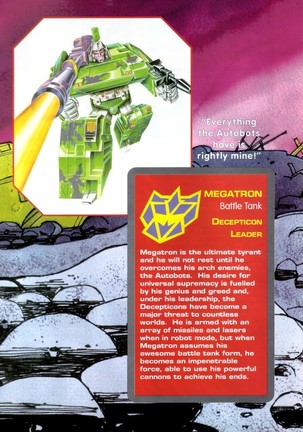 Megatron profile.
Megatron profile.
Skram meanwhile is puzzled as to why Grimlock hasn’t made their meeting, but it turns out a mysterious purple cameo robot with a big grin has knocked out the Dinobot and is watching...
Back in London, Bludgeon gets a report from his main right hand man Krok...
No, wait... Tornado. Who the hell is Tornado? Where’s Krok? Is he up to something mysterious that will reveal itself in he next issue?
Anyway Tornado reveals they’re nearly out of Energon, which rather undermines the heroic charge of Optimus Prime through the Decepticons troops that, though not as brutal as its counterpart in the American comic when he comes to Earth, does smash up Ramjet pretty well.
Pleasingly, and probably because of the requirement to sell the toys, the other Autobots are not useless at the side-lines and instead throw themselves into the battle with aplomb.
And, as ever, “Marvel” Prime is at his best when solving his issues with his fists as he has no truck with Bludgeon’s mysticism, nor his plan to steal the Matrix and use it to power his own new army he has up on the Warworld. So Prime just beats the tar out of him and, in keeping with the ‘90’s aesthetic, declares he’s had enough being “Freedom is the right of all sentient beings” guy, and will now not rest until the Decepticons are a memory.
Which is where a memory he’d rather not have seen again shows up, as Megatron reveals himself in his new tank body and thanks Prime for taking care of Bludgeon so he can take back Decepticon leadership! Which might have been a surprise if this moment wasn’t the (also by Smith?) cover.
Still, this is a solid romp that only really suffers from being a bit confused as to what it wants to be, a fresh new start or a direct follow on from Marvel 332. Still, it’s a valid alternative to its American counterpart and it’s actually impressive how it squeezes several US plots together and still makes sense. There clearly could have been a future in this sort of thing, though it won’t get a chance to really go for it.
Back in London, Bludgeon gets a report from his main right hand man Krok...
No, wait... Tornado. Who the hell is Tornado? Where’s Krok? Is he up to something mysterious that will reveal itself in he next issue?
Anyway Tornado reveals they’re nearly out of Energon, which rather undermines the heroic charge of Optimus Prime through the Decepticons troops that, though not as brutal as its counterpart in the American comic when he comes to Earth, does smash up Ramjet pretty well.
Pleasingly, and probably because of the requirement to sell the toys, the other Autobots are not useless at the side-lines and instead throw themselves into the battle with aplomb.
And, as ever, “Marvel” Prime is at his best when solving his issues with his fists as he has no truck with Bludgeon’s mysticism, nor his plan to steal the Matrix and use it to power his own new army he has up on the Warworld. So Prime just beats the tar out of him and, in keeping with the ‘90’s aesthetic, declares he’s had enough being “Freedom is the right of all sentient beings” guy, and will now not rest until the Decepticons are a memory.
Which is where a memory he’d rather not have seen again shows up, as Megatron reveals himself in his new tank body and thanks Prime for taking care of Bludgeon so he can take back Decepticon leadership! Which might have been a surprise if this moment wasn’t the (also by Smith?) cover.
Still, this is a solid romp that only really suffers from being a bit confused as to what it wants to be, a fresh new start or a direct follow on from Marvel 332. Still, it’s a valid alternative to its American counterpart and it’s actually impressive how it squeezes several US plots together and still makes sense. There clearly could have been a future in this sort of thing, though it won’t get a chance to really go for it.
The comic promotes itself as actually being a Transformer, and it very much is a big stepping stone between the Marvel UK style and the current British newsagent comic of a bunch of free gifts that happen to have a magazine in there somewhere.
This starts with some attached stickers, where you can have such memorable and character appropriate lines such as Grimlock saying “Fight for what you believe in”. The Megatron one is good fun though.
Inside, the “Transforming Comic” basically boils down to a gatefold cover and a massive poster of Optimus and Megatron facing off (probably by Smith as well). The cover folds out to reveal several very short character profiles for Megatron, the strangely popular Ramjet, Grimlock and Optimus (whose motto is now “Even one Decepticon is one too many”), all using toy box art.
The equivalent of the Transformation page again makes the book feel very unsure as to what it is, recapping the story so far once more and emphasising this is a continuation of the previous comic, whilst at the same time saying this is “Ground Zero” and a whole new start with all new characters.
The Hardware is a straightforward list of all the toys currently available, British names and all. Which in pre-internet days would have been handy for kids.
The next issue page is something of a curiosity as it features what looks like a poor quality reproduction of some art of the Dinobots in their G1 colours. I don’t recognise it and it doesn’t seem to be from any of the following issues. Possibly it’s an unused cover that was dropped for getting the colours wrong?
But before we hit the second issue, a lot at the stories that this opening was technically replacing...
1992-1994 SPECIALS
1994-2003
COMMENT
KO-FI
This starts with some attached stickers, where you can have such memorable and character appropriate lines such as Grimlock saying “Fight for what you believe in”. The Megatron one is good fun though.
Inside, the “Transforming Comic” basically boils down to a gatefold cover and a massive poster of Optimus and Megatron facing off (probably by Smith as well). The cover folds out to reveal several very short character profiles for Megatron, the strangely popular Ramjet, Grimlock and Optimus (whose motto is now “Even one Decepticon is one too many”), all using toy box art.
The equivalent of the Transformation page again makes the book feel very unsure as to what it is, recapping the story so far once more and emphasising this is a continuation of the previous comic, whilst at the same time saying this is “Ground Zero” and a whole new start with all new characters.
The Hardware is a straightforward list of all the toys currently available, British names and all. Which in pre-internet days would have been handy for kids.
The next issue page is something of a curiosity as it features what looks like a poor quality reproduction of some art of the Dinobots in their G1 colours. I don’t recognise it and it doesn’t seem to be from any of the following issues. Possibly it’s an unused cover that was dropped for getting the colours wrong?
But before we hit the second issue, a lot at the stories that this opening was technically replacing...
1992-1994 SPECIALS
1994-2003
COMMENT
KO-FI
